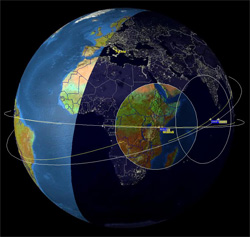Pinpointing Earthly Gamma Rays
Short pulses of gamma rays, which have more energy than x rays, are sometimes produced in thunderstorms. In the 17 September Physical Review Letters, a team uses satellite data to find the locations of sources of such pulses with unprecedented accuracy. The results will help theorists model these surprising emissions and clarify whether and how they are related to lightning.
Gamma rays give astrophysicists clues about cataclysmic astronomical events. But in 1994 researchers were surprised to detect bursts of gamma rays hitting their satellite-based detectors from the Earth below. These “terrestrial gamma-ray flashes,” or TGFs, were about a millisecond long and were traced to large tropical thunderstorms. The storms’ high electric fields are thought to accelerate electrons close to the speed of light in a complex “runaway” process; the TGFs are the “braking” radiation (bremsstrahlung) that these speedy electrons emit as they plow through the air. But the details of where and how this process begins, and how it may be connected to lightning in the storms, are still not clear.
New satellite results are illuminating this issue. The Italian Space Agency launched the AGILE satellite in 2007 to explore astrophysical events, but “later we recognized we could use it to look at terrestrial phenomena,” says Martino Marisaldi of the Italian National Institute for Astrophysics (INAF) in Bologna, Italy. Over the past year, AGILE and another satellite called Fermi showed that some of the gamma rays have extraordinarily high energies–at least 60 million electron-volts (MeV) in the AGILE data. “These high energy tails were unexpected,” Marisaldi says.
To find the atmospheric sources of TGFs, researchers have relied on pairing satellite-detected pulses with simultaneous electrical discharges measured on the ground, but the AGILE team wanted a more reliable measure. The special, direction-sensitive detector on board AGILE detects a lot of unrelated photons, so the team first used calorimeter data to identify bursts of gamma rays with properties similar to known TGFs. Then they searched data from the direction-sensitive detector for an individual gamma ray photon that had arrived at about the same time. This detector uses the trail of electron-positron pairs created by the gamma ray to piece together its propagation direction.
From a year and a half of data, the team identified nine gamma ray photons whose origins could be reliably determined. Each of the nine came from within 400 kilometers of the spot directly below the satellite, even though much more distant events could have been seen. The angle of the beam, no more than 35 degrees from straight up, suggests that the electric field that had accelerated the emitting electrons was also close to vertical.
With this measurement “you can actually point back to the storm” that emitted the pulses, says Joseph Dwyer of the Florida Institute of Technology in Melbourne. The angle of the beam also affects how much of the atmosphere the beam passed through, which is critical for modeling how many gamma rays were lost in transit, he notes. “This field is so new that when you get a measurement like this it tends to be a fairly large step forward.”
The new result “is a strong constraint for the models,” agrees Doug Rowland of NASA’s Goddard Space Flight Center, in Greenbelt, Maryland. The conclusions support the results from the previous, less-direct studies, he notes. “But it didn’t have to be the same answer. Now we have a bit more confidence.”
–Don Monroe
Don Monroe is a freelance science writer in Murray Hill, New Jersey.
More Information
Thunderhead Accelerator (2009 Focus story on long-duration gamma-ray bursts from thunderstorms)





